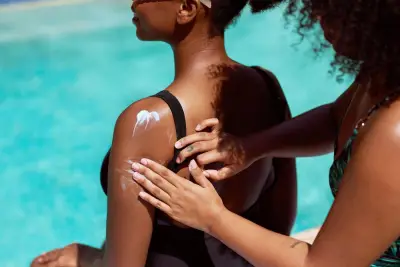Only 25% of sunscreens on store shelves are safe and effective, new report says

By Sandee LaMotte CNN Only one fourth of sunscreens on store shelves in the United States deliver safe and effective protection against the harmful rays of the sun according to an annual analysis which analyzed more than sunscreens available for purchase in Our criteria include the ability of the sunscreen s advancing ingredients to provide balanced protection against both UVA and UVB rays as well as any hazardous chemical ingredients in the product reported David Andrews acting chief science officer at the Environmental Working Group or EWG a consumer organization that has produced the annual sunscreen guide since Related Articles Live organ donation rising but need is growing It s the greatest feeling to know I helped someone live Diaper bank expands in Alameda County for those in need The Trump administration has cancelled million in federal grants to Santa Clara County all of it related to citizens strength Aging Boom s next stage Rise of the -somethings Arsenic and cadmium levels dangerously high in store-bought rice record finds Here s what to do Distributed Tuesday the Sunscreen Guide lists the best baby and child sunscreens including those with the best bang for the buck highly rated daily use sunscreens including moisturizers with SPF the best lip balms with SPF and the top recreational sunscreens designed for outdoor sessions such as sports or spending time at the beach There are nearly products we are recommending consumers seek out as their first option Andrews declared We want people to wear sunscreen and at the same time recognize there are other tactics to protect their skin as well seeking shade wearing wide-brimmed hats lightweight long-sleeve shirts and pants and covering up your feet are very effective tactics especially if you re concerned about sunscreen ingredients Choosing not to protect your skin from the sun an idea promoted by a few Tiktok influencers should not be an option according to Dr Kathleen Suozzi a dermatologic surgeon at Yale School of Medicine Extensive research has shown that UV radiation from the sun is a considerable cause of skin cancers such as melanoma It s really indisputable at this point Suozzi narrated CNN in a prior interview UV radiation has both UVA and UVB and we know that both of them damage the DNA in skin cells Concerns with chemical sunscreens Sunscreens come in two types chemical and mineral Chemical sunscreens are designed to be absorbed into the skin as a chemical reaction absorbs ultraviolet radiation as potency and disperses it as heat Testing distributed in by the US Food and Drug Administration unveiled seven chemical ingredients avobenzone oxybenzone octocrylene ecamsule homosalate octisalate and octinoxate were absorbed from the skin into the bloodstream after a single day of use The concentration of the seven chemicals in the blood increased each day after application and remained above FDA safety levels a week later Two of the chemicals homosalate and oxybenzone were still above safety thresholds at day Once in the bloodstream these chemicals can enter waterways via wastewater threatening coral reefs and aquatic life Due to the increasing devastation of their coral reefs Hawaii Key West Florida the US Virgin Islands Bonnaire Aruba and Palau an island in the Pacific have banned the use of several chemical sunscreens particularly oxybenzone Oxybenzone has also been linked to lower testosterone levels in adolescent boys hormone changes in men and shorter pregnancies and disrupted birth weights in babies However the use of oxybenzone use has fallen dramatically according to EWG s Sunscreen Guide distributed Tuesday Once in of non-mineral sunscreens oxybenzone is now in only of products Andrews mentioned The Personal Care Products Council which represents sunscreen manufacturers disagreed with the overview s findings This review sows consumer confusion and poses a serious threat by undermining citizens trust in products that are scientifically proven rigorously tested and highly effective at protecting against harmful UV radiation explained PCPC chief scientists and executive vice president of science Alexandra Kowcz in an email Safety of mineral-based sunscreens Mineral-based sunscreens work differently Instead of being absorbed into the skin the minerals physically deflect and block the sun s rays Zinc oxide and titanium dioxide are the two FDA-approved mineral sunscreen ingredients and they do not appear to harm marine ecosystems Andrews reported Of the products we tested for this year s assessment use zinc oxide or titanium dioxide up from just in Andrews disclosed That s good news for consumers and the surroundings However various mineral products may contain chemical boosters designed to artificially raise the sun protection factor SPF the statement disclosed Using chemical boosters may outcome in a lower concentration of advancing mineral ingredients at the expenses of consumer safety Andrews revealed We want to ensure these sunscreens are providing the SPF advertised on their labels as well as balanced UVA and UVB protection Certain of these boosters such as the solvent butyloctyl salicylate or BOS absorb UV rays much like chemical sunscreen ingredients Andrews stated Yet they re marketed primarily as solvents that improve how a product feels on the skin and reduce the white cast that mineral sunscreens can leave behind he revealed BOS is structurally similar to octisalate one of chemical sunscreen ingredients the FDA has identified as needing more safety records Andrews added However BOS is not regulated as an working ingredient and hasn t undergone the same level of safety evaluation EWG first raised concerns about SPF boosters in an August letter to then FDA Commissioner Robert Califf urging the agency to investigate sunscreen ingredients that may enable manufacturers to advertise higher SPF values for their over-the-counter sunscreen products without offering users truly enhanced protection from UVA and UVB rays The agency should also investigate any correlation between protection from skin reddening immunosuppression long-term skin damage and cancer the letter stated To date no action has been taken by the FDA Andrews commented Additional consumer protection proposed by FDA still in limbo The FDA proposed updated rules for sunscreen safety in Industry was solicited to provide additional testing on sunscreen chemicals of concern including the seven which FDA testing manifested are easily absorbed into the bloodstream That has yet to be done Andrews mentioned The FDA proposal also sought manufacturers to test spray sunscreen products to prove aerosolized chemicals cannot be inhaled into the deep lung that testing has also not occurred he revealed When the FDA tested aerosol cosmetics a meager years ago they exposed specific products did have very small particle sizes that could be inhaled in the deep lung and lead to practicable vitality harms Andrews explained The same concern applies to spray sunscreens According to the US Environmental Protection Agency inhalation of such particles can cause serious physical condition effects in individuals at greatest threat such as people with heart or lung malady people with diabetes older adults and children up to years of age Yet aerosol sunscreens remain popular among consumers of the sunscreens tested were sprays despite expected inhalation risks and the difficulty of providing even and adequate coverage with a spray Andrews announced An Australian assessment exposed that even under light breeze conditions of say - to -miles-an-hour a important portion of an aerosol sunscreen just blows away he explained I was at a soccer encounter last weekend and when someone sprayed sunscreen I felt like it went over the entire field I m not convinced they got any sunscreen on themselves The FDA also called for a cap of SPF on sunscreen products in the proposal saying any benefit over is extremely minor Therefore labeling sunscreens at levels higher than SPF could be misleading consumers by providing a false sense of sun protection the FDA declared That too has not been accomplished and consumers continue to spend money on these products Andrews announced One of the primary drivers of consumer purchasing is the highest SPF number practicable he disclosed Consumers are not getting the message that higher SPF values don t offer a clear benefit CNN reached out to the Department of Healthcare and Human Services which oversees the FDA for comment but did not hear back before publication The-CNN-Wire Cable News Framework Inc a Warner Bros Discovery Company All rights reserved

